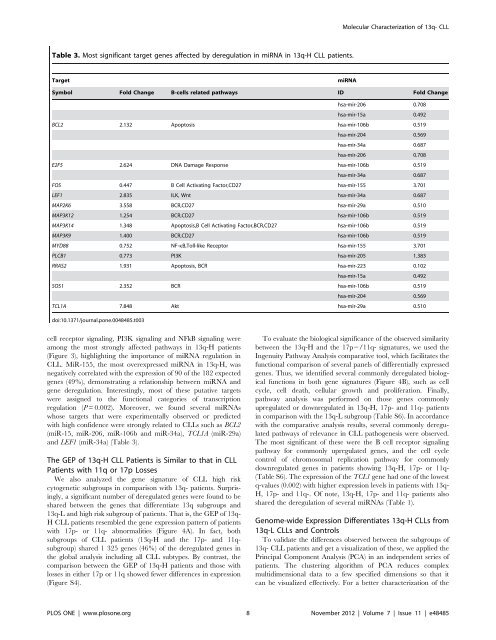Alberto Risueño Pérez - Gredos - Universidad de Salamanca
Alberto Risueño Pérez - Gredos - Universidad de Salamanca
Alberto Risueño Pérez - Gredos - Universidad de Salamanca
Create successful ePaper yourself
Turn your PDF publications into a flip-book with our unique Google optimized e-Paper software.
Table 3. Most significant target genes affected by <strong>de</strong>regulation in miRNA in 13q-H CLL patients.<br />
Target miRNA<br />
Symbol Fold Change B-cells related pathways ID Fold Change<br />
hsa-mir-206 0.708<br />
hsa-mir-15a 0.492<br />
BCL2 2.132 Apoptosis hsa-mir-106b 0.519<br />
hsa-mir-204 0.569<br />
hsa-mir-34a 0.687<br />
hsa-mir-206 0.708<br />
E2F5 2.624 DNA Damage Response hsa-mir-106b 0.519<br />
hsa-mir-34a 0.687<br />
FOS 0.447 B Cell Activating Factor,CD27 hsa-mir-155 3.701<br />
LEF1 2.835 ILK, Wnt hsa-mir-34a 0.687<br />
MAP2K6 3.558 BCR,CD27 hsa-mir-29a 0.510<br />
MAP3K12 1.254 BCR,CD27 hsa-mir-106b 0.519<br />
MAP3K14 1.348 Apoptosis,B Cell Activating Factor,BCR,CD27 hsa-mir-106b 0.519<br />
MAP3K9 1.400 BCR,CD27 hsa-mir-106b 0.519<br />
MYD88 0.752 NF-kB,Toll-like Receptor hsa-mir-155 3.701<br />
PLCB1 0.773 PI3K hsa-mir-205 1.383<br />
RRAS2 1.931 Apoptosis, BCR hsa-mir-223 0.102<br />
hsa-mir-15a 0.492<br />
SOS1 2.352 BCR hsa-mir-106b 0.519<br />
hsa-mir-204 0.569<br />
TCL1A 7.848 Akt hsa-mir-29a 0.510<br />
doi:10.1371/journal.pone.0048485.t003<br />
cell receptor signaling, PI3K signaling and NFkB signaling were<br />
among the most strongly affected pathways in 13q-H patients<br />
(Figure 3), highlighting the importance of miRNA regulation in<br />
CLL. MiR-155, the most overexpressed miRNA in 13q-H, was<br />
negatively correlated with the expression of 90 of the 182 expected<br />
genes (49%), <strong>de</strong>monstrating a relationship between miRNA and<br />
gene <strong>de</strong>regulation. Interestingly, most of these putative targets<br />
were assigned to the functional categories of transcription<br />
regulation (P = 0.002). Moreover, we found several miRNAs<br />
whose targets that were experimentally observed or predicted<br />
with high confi<strong>de</strong>nce were strongly related to CLLs such as BCL2<br />
(miR-15, miR-206, miR-106b and miR-34a), TCL1A (miR-29a)<br />
and LEF1 (miR-34a) (Table 3).<br />
The GEP of 13q-H CLL Patients is Similar to that in CLL<br />
Patients with 11q or 17p Losses<br />
We also analyzed the gene signature of CLL high risk<br />
cytogenetic subgroups in comparison with 13q- patients. Surprisingly,<br />
a significant number of <strong>de</strong>regulated genes were found to be<br />
shared between the genes that differentiate 13q subgroups and<br />
13q-L and high risk subgroup of patients. That is, the GEP of 13q-<br />
H CLL patients resembled the gene expression pattern of patients<br />
with 17p- or 11q- abnormalities (Figure 4A). In fact, both<br />
subgroups of CLL patients (13q-H and the 17p- and 11qsubgroup)<br />
shared 1 325 genes (46%) of the <strong>de</strong>regulated genes in<br />
the global analysis including all CLL subtypes. By contrast, the<br />
comparison between the GEP of 13q-H patients and those with<br />
losses in either 17p or 11q showed fewer differences in expression<br />
(Figure S4).<br />
Molecular Characterization of 13q- CLL<br />
To evaluate the biological significance of the observed similarity<br />
between the 13q-H and the 17p2/11q- signatures, we used the<br />
Ingenuity Pathway Analysis comparative tool, which facilitates the<br />
functional comparison of several panels of differentially expressed<br />
genes. Thus, we i<strong>de</strong>ntified several commonly <strong>de</strong>regulated biological<br />
functions in both gene signatures (Figure 4B), such as cell<br />
cycle, cell <strong>de</strong>ath, cellular growth and proliferation. Finally,<br />
pathway analysis was performed on those genes commonly<br />
upregulated or downregulated in 13q-H, 17p- and 11q- patients<br />
in comparison with the 13q-L subgroup (Table S6). In accordance<br />
with the comparative analysis results, several commonly <strong>de</strong>regulated<br />
pathways of relevance in CLL pathogenesis were observed.<br />
The most significant of these were the B cell receptor signaling<br />
pathway for commonly upregulated genes, and the cell cycle<br />
control of chromosomal replication pathway for commonly<br />
downregulated genes in patients showing 13q-H, 17p- or 11q-<br />
(Table S6). The expression of the TCL1 gene had one of the lowest<br />
q-values (0.002) with higher expression levels in patients with 13q-<br />
H, 17p- and 11q-. Of note, 13q-H, 17p- and 11q- patients also<br />
shared the <strong>de</strong>regulation of several miRNAs (Table 1).<br />
Genome-wi<strong>de</strong> Expression Differentiates 13q-H CLLs from<br />
13q-L CLLs and Controls<br />
To validate the differences observed between the subgroups of<br />
13q- CLL patients and get a visualization of these, we applied the<br />
Principal Component Analysis (PCA) in an in<strong>de</strong>pen<strong>de</strong>nt series of<br />
patients. The clustering algorithm of PCA reduces complex<br />
multidimensional data to a few specified dimensions so that it<br />
can be visualized effectively. For a better characterization of the<br />
PLOS ONE | www.plosone.org 8 November 2012 | Volume 7 | Issue 11 | e48485
















